Soviet fighter-bombers in battle. Part 2
In the 1982 year, at the time of the outbreak of hostilities in Lebanon, the Syrian air force had Su-20 fighter-bombers, as well as one squadron of the newest Su-22M. From the first days of the war, these planes were actively used for bombing the positions of the Israeli forces. On June 10, eight Su-22Ms, each armed with eight FAB-500 bombs, struck the headquarters of Israeli forces in southern Lebanon. The target was destroyed (with heavy losses for Israelis) at the cost of killing seven planes shot down by the Israeli Air Force F-16A fighters (instead of delivering a massive strike, the Syrians carried out a series of successive raids, which allowed the Israeli defense to organize effective counteraction). Aerial reconnaissance was another area of use for Su-22M in Lebanon (the aircraft were completed with KKR-1 containers).
In total, during the hostilities in Lebanon, Su-22M fighter-bombers, together with the MiG-23BN, made 42 sorties, destroying 80 tanks and two battalions of Israeli motorized infantry (with the loss amounted to seven Su-22M and 14 MiG-23BN). During the battles, the more advanced Su-22Ms performed better than the MiG-23BN.
At the cost of heavy losses, the Syrians managed to stop the advance of the enemy along the highway to Damascus. Syrian losses aviation could be much smaller, use more reasonable tactics.
Syrian Su-22M continue to fight today, striking at positions supported by western rebels.
Unlike most Arab countries, Iraq could pay for the supply of arms with “live” money, which, together with its intransigent stance towards Israel and the United States, made Iraq an important ally of the USSR. In addition, the country was a counterweight to Iran during the years of the Shah’s rule, and after Ayatollah Khomeini’s arrival, with his extremely hostile policies not only towards the United States, but also towards the Soviet Union.
The first MiG-23BN fighter-bombers began to enter service with the Iraqi Air Force in the 1974 year, a total of about 80 aircraft were delivered. These aircraft received baptism of fire during the seven-year Iran-Iraq war - one of the bloodiest conflicts of the end of the 20th century, mixed with ethnic and religious disagreements and sharing disputed border areas rich in oil.
The Iraqi MiGs stormed the enemy tank columns, participated in the “tanker war” and bombed the Iranian cities.
As in other Arab countries, Su-20 and Su-22 were ordered in parallel. Iraq successfully applied them in combat operations against Iran.

During the operation "Desert Storm" Su-20 and Su-22M did not participate in the battles. In the future, some of the aircraft of this type flew to Iran, where it is still used.
In January-February 1995, the Su-22 air force of Peru was involved in hostilities with Ecuador during the next border conflict.
Ecuadorian infantry, armed with Russian Igla, 10 February, shot down one Su-22. However, according to Western observers, the superiority of the Peruvian air force and the effective actions of strike aircraft predetermined Peru’s victory in this war.
In the armed conflict in Angola, a significant role was played by the MiG-23BN, which were piloted by Cubans. MiGs provided direct aviation support and struck blows at enemy strongholds. Their role in the battle of Kuito-Kuanavale, sometimes called "Angolan Stalingrad" is very large. In 1987-1988, the neighborhood of Kuito-Kuanavale turned into a fierce battle field between Angola-Cuban and South African troops using hundreds of tanks and armored personnel carriers, dozens of combat aircraft and helicopters. In August, the 1988 of the year, the troops from Yuaru left Angola, and the Cuban MiG-23 returned to combat duty and support counterguerrilla operations. During the withdrawal of the Cuban contingent in 1989, all Mig-23BN returned to Cuba. The Cuban command did not report any losses.

Prior to that, Cubans fought on their shock MiGs in Ethiopia in 1977 — 1978, in the Ethiopian-Somali war. Thanks to the help of the USSR and the participation of Cubans on the side of Ethiopia, this conflict ended with a crushing defeat of Somalia, after which this state practically ceased to exist.
At the beginning of the 90-s in service, Ethiopia was still around 36 MiG-23BN. These aircraft participated in the war with Eritrea at the end of the 90 and the beginning of the 2000.
Angolan air forces used Su-22M against UNITA partisans during the civil war in the country. At the final stage of the conflict, the Angolan Air Force, with the help of South African mercenary pilots, succeeded in crushing the base camps of this group, which led to the conclusion of a peace agreement and the end of the civil war.
Su-17М4 was actively used by the Russian Air Force during the First Chechen. They were involved in attacking the airfield in Grozny, as well as during the battles for the city itself. It was noted the effective use of precision-guided munitions to defeat detached fortified buildings.
According to Air International magazine, at the time of the collapse of the USSR, the Su-17 of all modifications was equipped with 32 shock regiments, 12 reconnaissance regiments, one separate reconnaissance squadron, and four training regiments.
Of course, if this aircraft was not necessary and not effective, it was not produced for a long time, in such quantities and would not be in demand abroad. The export price of these aircraft, according to the magazine, ranged from $ 2 million for Su-20 (for Egypt and Syria) to $ 6-7 million for Su-22М4 of the latest modifications acquired by the three Warsaw Pact countries at the end of 1980-s. For comparison, the closest western equivalent of the SEPECAT Jaguar was offered for $ 8 million in the 1978 year.
Su-17 embodies the optimal combination by the criterion of price-efficiency, which was the reason for its wide distribution and long-term operation. Soviet fighters, bombers, in terms of their shock capabilities, were not inferior to similar Western machines, often surpassing them in flight data.
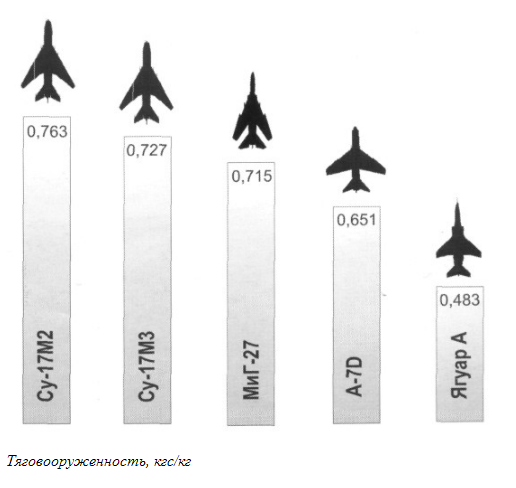
The MiG-27 fighter-bombers, which are a further development option for the MiG-23B, were among the most massive and sophisticated aircraft of the Soviet Air Force adapted for the European theater of operations. However, for almost fifteen years of service, none of them had a chance to take part in real combat operations. Until the very last months, even during the years of the Afghan war, the question of sending them to the Air Force of the 40 Army did not arise, and therefore the combat examination became all the more unexpected for them.
There were reasons for this. The tasks of IBA in the air forces of the 40-th army were properly carried out by Su-17 of various modifications. Machines, called "swifts", enjoyed the fame of reliable and unpretentious aircraft, which were, as they say, in its place. In addition, the basing of aircraft of the same type from year to year simplified the maintenance, supply and planning of combat missions, so objectively the question of switching to another type of fighter-bomber did not arise.
By the fall of 1988, the next replacement period arrived (according to the established practice, the IBA regiments replaced each other after a year of work in October-November). But the "henchmen" shelves from SAWO without that, barely returning from Afghanistan, continually broke from their bases, continuing combat work "behind the river" from border airfields. There were not so many other regiments who had mastered combat use in the conditions of mountain-desert terrain. At the same time, IBA had another type of fighter-bomber - the MiG-27, which by the end of the 80-s had more than two dozen air regiments.
A natural proposal arose - to send to replace the MiG-27, in favor of which there were several arguments, the main of which was the possibility in the remaining months of the war to test the aircraft in real combat conditions. At the same time, the easiest and most reliable way was to resolve a question to which more than one military research study was devoted - which of the two machines created according to the same requirements with comparable characteristics, armament and avionics is more efficient.
Despite the presence of the MiG-27K, which had the greatest capabilities and the most respected pilots, the command decided not to include them in the group. The Afghan experience has unequivocally shown that in difficult mountain conditions, far from the calculated "barely intersected" terrain, it is not possible to use the full potential of the onboard equipment on a high-speed vehicle. Electronics and sighting systems were useless when searching for targets in the chaos of rocks, stones and greens. Quite often, it was impossible to single out the target from a height without prompting a ground or helicopter gunner. And even Kayre, the most advanced system then used in front-line aviation, was unable to take a small-sized object of impact on auto-tracking and target designation with short-term contact and maneuver. The reason was the lower border raised to 5000 and safe from the Stingers, which imposed serious restrictions on the use of the on-board aiming laser-television complex. As a result, small targets on the ground turned out to be beyond the detection range of the guidance equipment installed on the aircraft, since the optimum range of application heights for the KAB-500, UR X-25 and X-29 lay within 500-4000. Moreover, it was recommended to launch missiles at speeds of 800-1000 km / h from a flat dive, when it was almost impossible to see the object of impact and to guide because of the transience of convergence on one’s own. Costly guided munitions remained under these conditions. weapons attack aircraft, operating in close contact with aircraft gunners.
Another reason was that the MiG-27K, which carried the massive Kairu, had no armored cabins, which were by no means in a combat situation. By the time they were sent to the war, the MiG-27D and M had passed a special “Afghan” set of improvements.
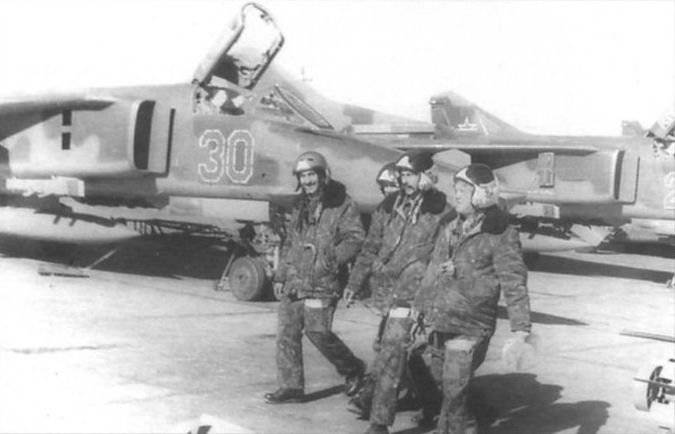
The usual version of the equipment MiG-27 consisted of two "five hundred" or four bombs weighing 250 or 100 kg, placed on the front ventral and underwing nodes. The most commonly used FAB-250 and FAB-500 of different types and models, OFAB-250-270. The use of large-caliber and demanding nature of the targets, mostly protected and difficult to vulnerable - to destroy the adobe duval or the thick adobe wall of the "weave" could not always. Even in the open, their striking effect (fragments and high-explosive effect) in manpower 1,7-2 times (depending on different conditions) was inferior to FAB-250, not to mention powerful “halftones”. When striking light structures, the latter generally had a higher efficiency in 2,5-3. Incendiary bombs ZAB-100-175 with thermite cartridges and ZAB-250-200 filled with sticky sticky mixture were also used. Although there was nothing much to burn in the mountains and villages, and the winter that started made ZAB even less effective, fire strikes gave a great psychological effect As a rule, such "gifts" could cover a fairly large area, and even small burning drops scattered around with a wide fan caused severe burns. RBC-250 and RBC-500 were used to defeat manpower, sweeping away all the life in a barrage of gaps within a radius of hundreds of meters.
The use of powerful NAR C-24 nicknamed "nails" in Afghanistan, in some cases was hampered by the restriction on flight altitude, launching 5000 meters could not be targeted, their maximum effective firing range was 4000 meters, C-5 and C-8 pencils , and there was no need to say - their sighting range was only 1800-2000 m. For the same reason, the “ballast” remained a powerful 30-mm six-barreled gun GSH-6-30, which had a speed of 5000 v / min and a powerful 390-gram projectile . Nevertheless, full ammunition for it (260 ammunition) was always on board.
In addition to the planned strikes, the MiG-27 were involved in conducting reconnaissance and percussion operations (RUD) —independent search and destruction, more commonly known as “free hunting.” Mostly they were carried out to search for caravans and individual cars, along paths and roads, which is why the throttle system sometimes deciphered as "reconnaissance of the road". The movement of dushmansky transport at night, when under the cover of darkness, caravan operators felt more confident, was especially enlivened. do not leave the garrisons and outposts. For 95 days of business trips, pilots of the 134-th APIB carried out, on average, 70-80 sorties, with 60-70 flying hours.
According to the results of the Afghan exam, the MiG-27 proved to be a reliable and durable machine. At the same time, the capabilities of the aircraft and its armament complex were far from being fully utilized, primarily because of the peculiarity of the theater of operations and the nature of the hostilities, accompanied by a multitude of restrictions.
The fighter-bomber, which was created to defeat small-sized mobile and stationary targets using a wide range of ammunition, was used exclusively for bombardment from high altitudes, due to which most of its aiming equipment and weapons could not be used.
A short-term use in Afghanistan did not allow an adequate assessment of the combat effectiveness of the MiG-27. Nevertheless, it was possible to evaluate some of its advantages: the MiG-27 favorably differed from the Su-17MZ and M4 fuel reserves in the internal tanks (4560 kg versus 3630 kg) and, accordingly, had a slightly longer range and duration of flight with equal loading. A more advantageous arrangement of the equipment compared to the “drying” allowed, if necessary, to expand the range, costing only one ventral PTB-800, while Su-17 had to carry two tanks of the same capacity at once, which increased take-off weight, degraded flight performance and reduced the number of suspension points of weapons. Downloading the MiG-27 for the Afghan environment has proven to be more convenient.
However, the MiG-27 was heavier - even with an equal fuel level and combat load with the Su-17, the “extra” 1300 kg of the weight of the airframe and equipment made themselves felt, which made the wing load and lower thrust-weight higher on the 10-12% (Excess kilograms required a greater fuel consumption of an already more “voracious” engine than the Su-17). The result was the worst aircraft volatility and take-off characteristics - the MiG-27 ran longer and gained more slowly. It was a bit simpler on landing, the design features of all-wheel consoles, as well as the bearing properties of the fuselage and overruns affected, thanks to which the landing speed of the MiG-27 was 260 km / h versus 285 km / h in Su-17М4, the mileage was slightly shorter .
MiG-27M was the only modification of the family of "twenty-seven", exported. In addition to the domestic Air Force, the recipient of the MiG-27 was India, which has long been one of the main buyers of Soviet weapons. After the delivery of a large batch of MiG-1981BN to 1982-23, the Indians turned their attention to the more advanced MiG-27. As a result, an agreement was signed between Moscow and Delhi, which provided for licensed production of the MiG-27M in India.
The Indians appreciated the capabilities of the shock MiGs, and actively used it in hostilities.
The “baptism of fire” MiG-23BN took place in May-July 1999 during the next Indo-Pakistani conflict, this time in Kargil, one of the districts of Jammu and Kashmir. From 26 May to 15 July, these aircraft made 155 30 combat missions% of those performed by all Indian attack aircraft in that war. 57-mm and 80-mm NAR, as well as 500-kg bombs, which were dropped by 130 t - 28% of the entire combat load of the Indian pilots on the enemy, were used to destroy enemy targets.
The Indian Air Force operated the MiG-23BN until 6 in March 2009. By that time, the total flight time of this type of aircraft was 154000 hours, 14 vehicles were lost in accidents and catastrophes.
The MiG-27ML link from 9-th AE also took part in the Kargil war. The first combat mission of “Bahadura” was made on 26 in May in the Batalik sector. Each of the four fighter-bombers carried forty 80-mm NARs. They attacked the mountain positions of the Pakistanis. Then they made a second run, during which they attacked the enemy with 30-mm cannons.
They had to meet fierce fire from the ground. On the second run, the flight-lieutenant K. Nachikete car flashed the engine. The pilot ejected and was captured. Islamabad claimed that the plane hit an anti-aircraft gun, but the Indian side denied this and blamed the loss on engine failure. More in combat missions "Bahadura" did not suffer losses, but during daily operation, in accidents and disasters, the Indian Air Force lost twenty-one MiG-27M.
Much stress on the MiG-27 was used during the civil war in neighboring Sri Lanka, where government troops fought a fierce armed struggle against the separatist organization of the Tigers of Tamil Eelam Liberation Tigers (LTTE). In the summer of 2000, the government acquired a batch of six Ukrainian MiG-27Ms and one “Sparky” MiG-23UB from the Lvov storage base.
At first, the vehicles included 5 AE, where they served along with Chinese F-7, and at the end of 2007 from MiGs they formed a new 12 squadron of which was the Katunayake airfield, located near the capital's airport. The MiGs unexpectedly showed themselves to be extremely efficient aircraft, which quickly forced the Tigers to hide their teeth. Among the most important objects destroyed by them, the destruction of the LTTE telecommunications center in the region of Kilinochchi should be noted. The MiG-27 pilots were very successful against small speedboats. In general, over the 5 months of intense fighting, the MiG-27M dropped more than 700 tons of bombs on various targets, which largely contributed to the victory of the government forces.
The mercenaries from South Africa and Europe, some of whom had previously served in the air forces of the NATO countries, flew on the vehicles arriving from Ukraine. According to their reviews, the MiG-27М proved to be an excellent aircraft, in many respects superior to the Western counterparts Jaguar and Tornado. The MiGs fought in the same ranks as their former adversaries — the Israeli Kfirs, S.2 / C.7 (7 of such machines was also acquired by Sri Lanka). Moreover, PrNK-23М turned out to be more perfect in practice than the Israeli IAI / Elbit system, therefore MiG-27М were used as leaders, leading the Kfirov group. In the air, the Sri Lankan air force did not lose a single MiG. However, the Tigers' sabotage group managed 24 on July 2001 to conduct a daring raid on the Katunayake base, where it destroyed two MiG-27М and one MiG-23UB.
The MiG-27 (especially its later modifications) were never attack aircraft in the classic presentation, but were intended mainly for the "remote" defeat of the enemy using
guided weapons. Being much cheaper than the powerful Su-24 front-line bombers, they could inflict quite effective strikes on firing points, armored vehicles and positions of the enemy’s air defense, creating unprotected gaps in their combat formations, and therefore the decision to remove the aircraft of this type from the air force of the Russian Air Force looks like not fully justified.
In conclusion, I want to talk about the episode, which the author happened to be a witness. During the large-scale exercises of the Far Eastern Military District, in the autumn of 1989, several MiG-27 delivered a “conditional strike” on the RFP of the 5 Army (headquarters in Ussuriysk, Primorsky Krai), not far from the village of Kondratenovka.

The attack was made suddenly, at extremely low altitude, from different sides. The rapid flight of these dark green, carnivorous machines along the glens of the hills overgrown with fir trees and cedar trees, crashed into the memory forever. MiGs were able to pass through the terrain, remaining invisible to ground radar operators. The exit from the attack was just as swift. If this were a real blow, without a doubt, a significant part of radio stations and command and staff vehicles would have been destroyed and damaged, there would have been significant losses in command personnel. As a result, the control of units of the 5 Army would be disrupted. Shilki, who covered the area, could briefly “conditionally fire” MiGs only after they left the attack.
Based on:
http://vadimvswar.narod.ru/ALL_OUT/AiKOut02/MiG27/MiG27132.htm
http://vadimvswar.narod.ru/ALL_OUT/AiKOut02/MiG27/MiG27142.htm
http://aviapanorama.su/2003/02/istrebitel-bombardirovshhik-su-7b/
http://vadimvswar.narod.ru/ALL_OUT/AiKOut06/Su-7B/Su-7B080.htm
http://voenhronika.ru/
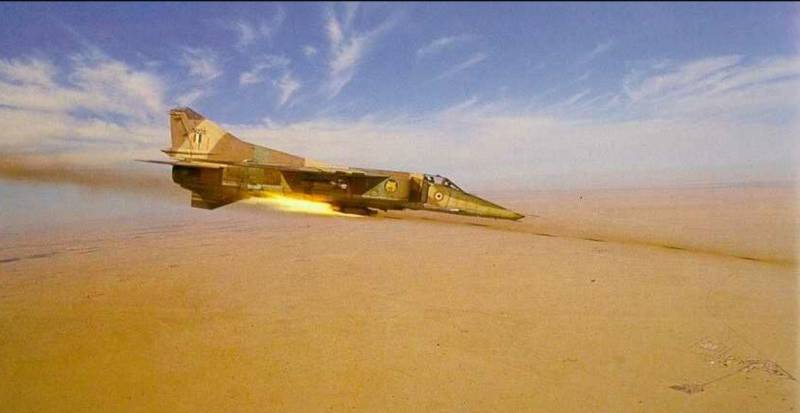
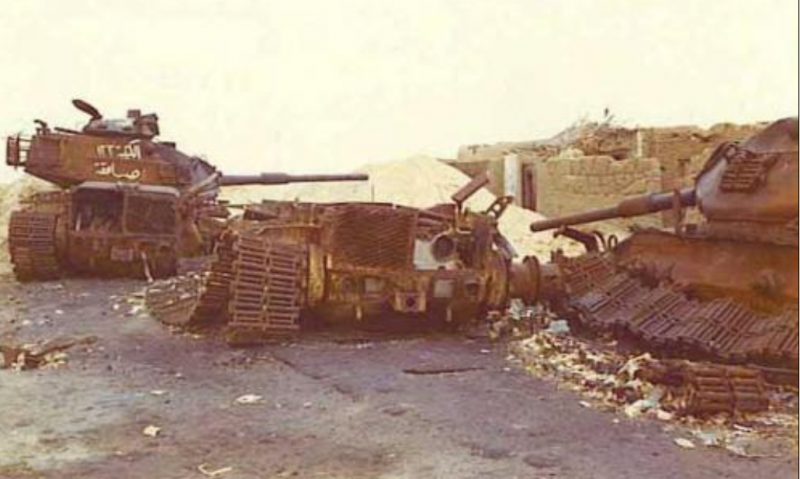
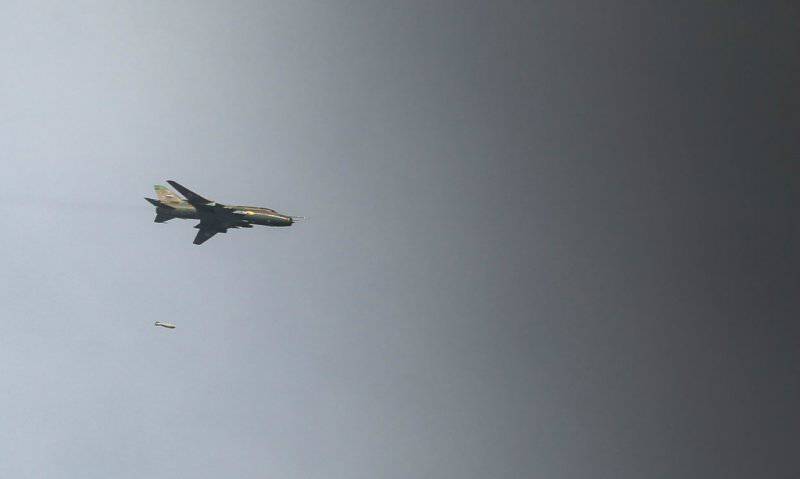
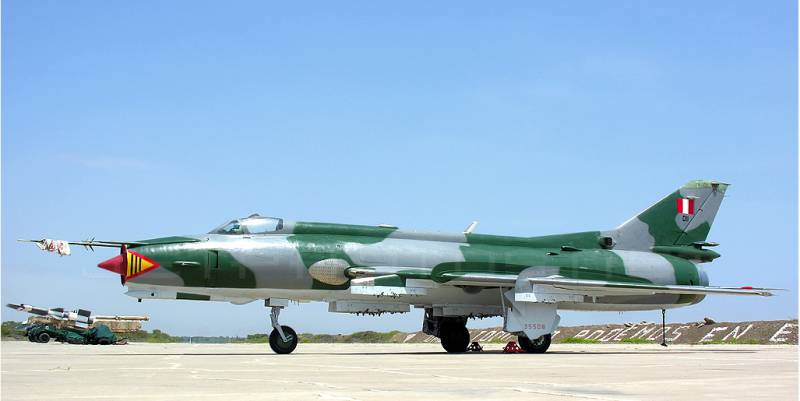
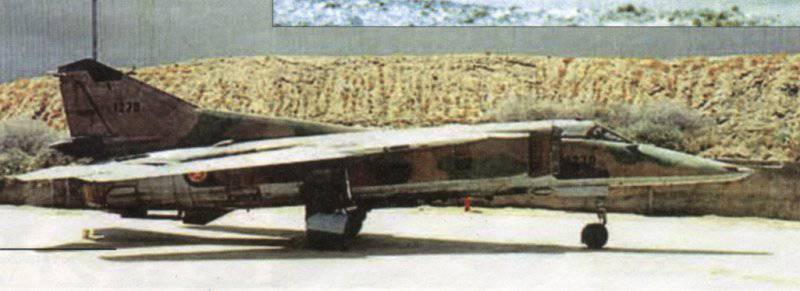
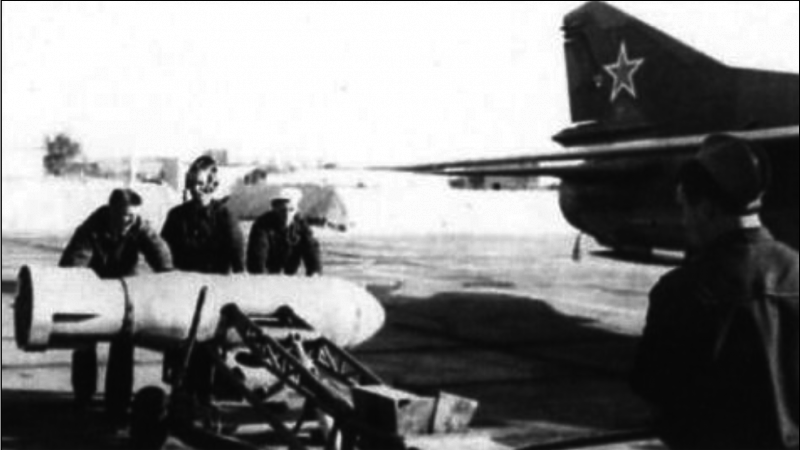

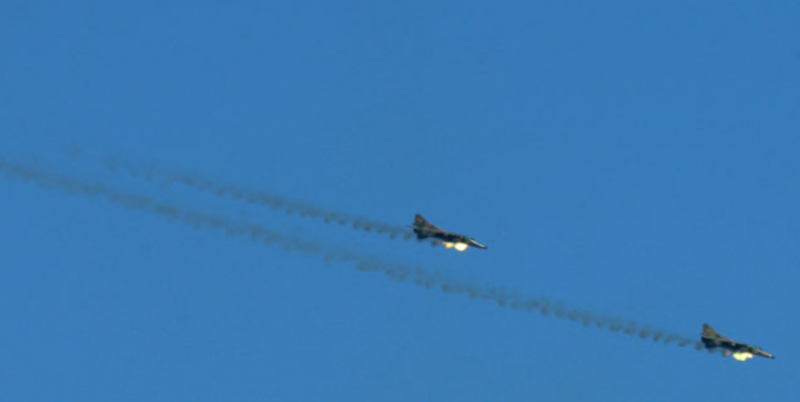
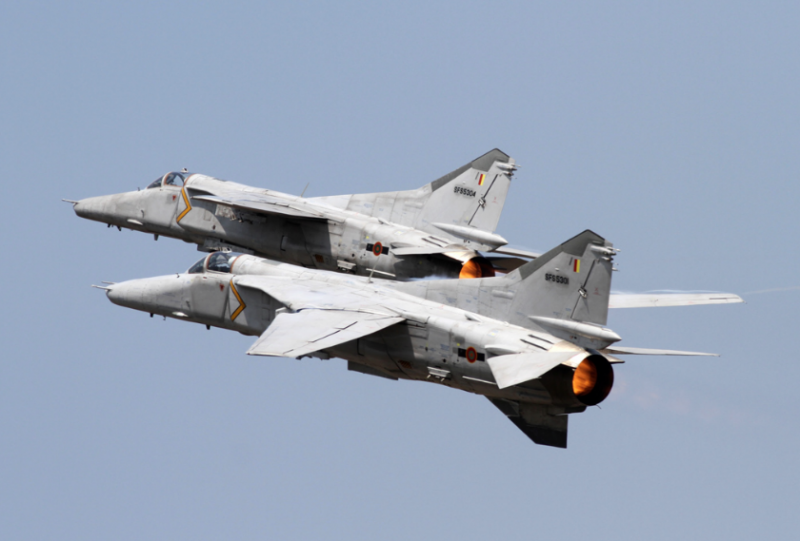
Information